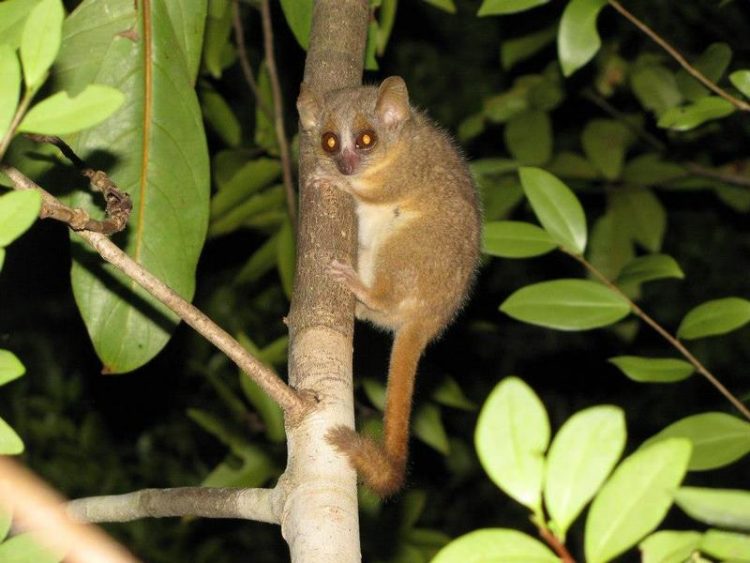Three new primate species discovered in Madagascar

Microcebus ganzhorni is named in honor of the Hamburg ecologist Prof. Jörg Ganzhorn who works on ecology and conservation in Madagascar for more than thirty years. Photo: G. Donati
Mouse lemurs are small, nocturnal primates, which are only found in Madagascar – and they all look very similar with their brown fur and large eyes. Different species can be distinguished reliably only by means of genetic methods. However, how great the difference between two populations has to be to define it as a new species is a source of continuous discussion.
“By using new, objective methods to assess genetic differences between individuals, we were able to find independent evidence that these three mouse lemurs represent new species,” says Peter Kappeler, Head of the Behavioral Ecology and Sociobiology Unit at the German Primate Center. In addition, the analysis confirmed the status of the previously described 21 species. “The genetic techniques we used could facilitate species identification, thus also contributing to further new descriptions in other animal groups,” says Peter Kappeler.
Only three years ago, the same research groups had described two new mouse lemur species. The closely related 30g Madame Berthe's mouse lemur is the smallest primate in the world. Scientists from the German Primate Center discovered it in 1993. Besides improved analytical methods, expeditions to remote and inaccessible forests contribute to the fact that the diversity of these distant relatives of humans becomes better known.
“To know the exact distribution area of individual species is necessary to identify functioning protected areas,” says Peter Kappeler, who has conducted research at the field station of the German Primate Center in Madagascar for more than 20 years. “Furthermore, this new information is an important element towards better understanding how biodiversity on Madagascar arose.”
Ganzhorn's mouse lemur (Microcebus ganzhorni) was named after the ecologist Professor Jörg Ganzhorn from Hamburg University, who has been engaged in research and protection of lemurs for decades. It was Ganzhorn who initiated the field research of the German Primate Center in Madagascar in the 1990s. Also in the Southeast of the “Big Island” Microcebus manitatra is to be found, whose name symbolizes the expansion of the range of a subgroup from western Madagascar. The third member, Microcebus boraha, is named after its location on the Island of Sainte Marie (in Malagasy Nosy Boraha).
According to the “Red List” of the IUCN more than 100 known species of lemurs are threatened by extinction and represent the world's most endangered group of mammals. Deforestation and hunting are the main causes of the threat to lemurs in one of the poorest countries of the world.
Original publication
Scott Hotaling, Mary Foley, Nicolette Lawrence, Jose Bocanegra, Marina Blanco, Rodin Rasoloarison, Peter Kappeler, Meredith Barrett, Anne Yoder and David Weis Rock (2016): Species discovery and validation in a cryptic radiation of endangered primates: coalescent based species delimitation in Madagascar's mouse lemurs. Molecular Ecology, doi:10.1111/mec.13604
Contact and notes for editors
Prof. Dr. Peter Kappeler
Tel: +49 551 3851-376
E-mail: pkappel@gwdg.de
Dr. Susanne Diederich (Kommunikation)
Tel: +49 551 3851-359 or +49 151 42616141
E-mail: sdiederich@dpz.eu
You can find printable images in our media library. This press release with additional information is also to be found on our website. Please send us copies of all publications.
The German Primate Center (DPZ) in Göttingen, Germany, conducts basic research on and with primates in the areas of infectious diseases, neurosciences and organismic biology. In addition, it operates four field stations abroad and is a competence and reference center for primate research. The DPZ is one of the 88 research and infrastructure institutions of the Leibniz Association in Germany.
http://www.dpz.eu/en/home/single-view/news/drei-neue-affenarten-auf-madagaskar-e…
Media Contact
All latest news from the category: Life Sciences and Chemistry
Articles and reports from the Life Sciences and chemistry area deal with applied and basic research into modern biology, chemistry and human medicine.
Valuable information can be found on a range of life sciences fields including bacteriology, biochemistry, bionics, bioinformatics, biophysics, biotechnology, genetics, geobotany, human biology, marine biology, microbiology, molecular biology, cellular biology, zoology, bioinorganic chemistry, microchemistry and environmental chemistry.
Newest articles

Combatting disruptive ‘noise’ in quantum communication
In a significant milestone for quantum communication technology, an experiment has demonstrated how networks can be leveraged to combat disruptive ‘noise’ in quantum communications. The international effort led by researchers…

Stretchable quantum dot display
Intrinsically stretchable quantum dot-based light-emitting diodes achieved record-breaking performance. A team of South Korean scientists led by Professor KIM Dae-Hyeong of the Center for Nanoparticle Research within the Institute for…

Internet can achieve quantum speed with light saved as sound
Researchers at the University of Copenhagen’s Niels Bohr Institute have developed a new way to create quantum memory: A small drum can store data sent with light in its sonic…





















